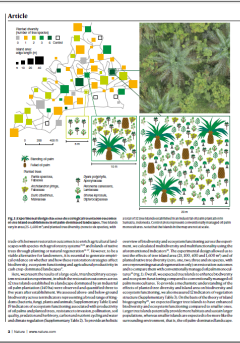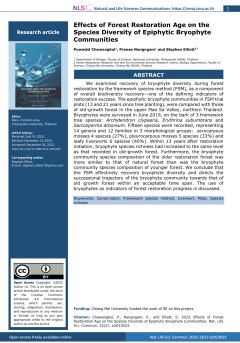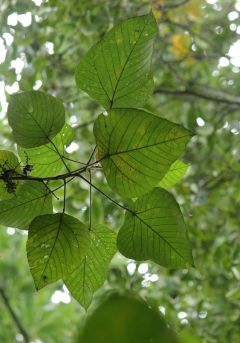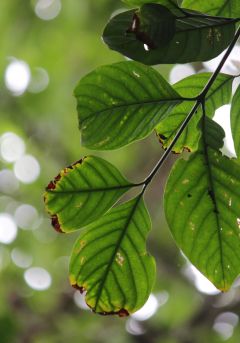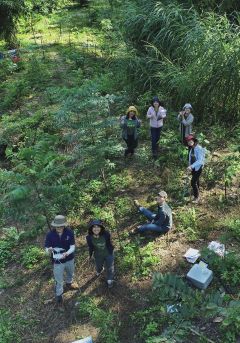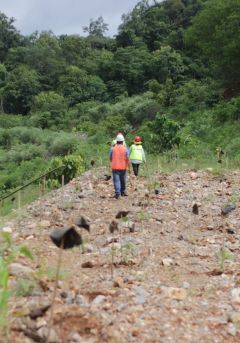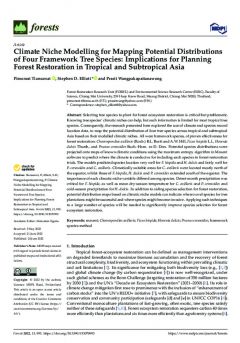The Nan Project, directed by Assist. Prof. Dr. Dia Shannon comprises 3 research initiatives:
-
From a Bare Mountain to a Regenerated Forest: compared landscape planting designs for forest restoration in Nan Province, sponsored by the National Science and Technology Development Agency (NSTDA), 2017 to 2020.
-
Forest Landscape Restoration and Community Well-being: supported by the Program Management Unit on Area Based Development (PMU A), 2020 to 2021.
-
Evaluating Changes and Ecosystem Services of Nan Restored Forests: funded by the National Science and Technology Development Agency (NSTDA), 2021 to 2022.
The research spans three districts of Nan Province—Pua, Phu Phiang and Wiang Sa—with three plots in each district. The project commenced with a survey of reference forest remnants, near the restoration sites, including i) the Nam Kaen - Nam Sa Watershed Forests (Phu Phiang District), supervised by the Royal Forest Department; ii) Mon Hin Kaew Community Forest (Pua District) and iii) Ban Muang Noeng Community Forest (Wiang Sa District). The survey involved documenting tree density, species diversity and phenology, as well as bird diversity, over three years. Such data were then compared with the same in restoration forests, established in the 3 districts.
Knowledge of the framework species method of forest ecosystem restoration was transferred to local communities and restoration plots of various sizes were planted with a range of indigenous framework tree species. Post-restoration activities include frequent weeding and fertilizer application, as well as the cutting of firebreaks in the dry season. Monitoring focused on survival and growth rates of each species, as well as the diversity of soil microbial communities. Ecosystem services, provided by the restored forests, including climate control, were evaluated, along with forest products used by local people. The effects of restoration on the quality of life of local people was also assessed. Currently, villagers who are project members continue to actively contribute to the care of the restored forest, to ensure its long-term health and growth.
In collaboration with:
Biodiversity
Biodiversity recovery is one of the main aims of forest restoration - but what to measure? Plants? Birds? Mammal? Learn simple monitoring techniques here.
1: ทฤษฎีเบื้องหลังการฟื้นฟู
หนังสือเล่มนี้ได้รวบรวมเนื้อหาครอบคลุมถึงการรบกวนที่ส่งผลต่อกระบวนการฟื้นตัวของธรรมชาติ ทำให้มวลชีวภาพลดลงและสภาพดินเปลี่ยนแปลงไป...
2: Tree islands enhance biodiversity and functioning in oil palm landscapes
ABSTRACT: In the United Nations Decade on Ecosystem Restoration, large knowledge gaps persist on how to increase biodiversity and ecosystem functioning in cash crop-dominated tropical landscapes....
3: Effects of forest restoration age on the species diversity of epiphytic bryophyte communities
ABSTRACT: We examined recovery of bryophyte diversity during forest restoration by the framework species method (FSM), as a component of overall biodiversity recovery—one of the defining...
4: Phenology of Five Tree Species for Restoration of Evergreen Forests on Doi Suthep
ABSTRACT: In an evergreen forest on Doi Suthep, Chiang Mai Province, multiple individuals of five tree species were observed monthly for their phenology, between March 2022 and February...
5: Phenology of Five Framework Tree Species on Doi Suthep
ABSTRACT: Climate change occurs for many reasons causing global temperature to rise affecting changes in abiotic factors such as air temperature, rainfall and relative humidity. These abiotic...
6: Use of drone RGB imagery to quantify indicator variables of tropical-forest-ecosystem degradation and restoration
ABSTRACT: Recognizing initial degradation levels is essential to planning effective measures to restore tropical forest ecosystems. However, measuring indicators of forest degradation is...
7: Living Fungi in an Opencast Limestone Mine: Who Are They and What Can They Do?
Abstract: Opencast limestone mines or limestone quarries are considered challenging ecosystems for soil fungi as they are highly degraded land with specific conditions, including high...
8: Multi-Scenario Simulations of Future Forest Cover Changes Influenced by Socio-Economic Development: A Case Study in the Chiang Mai-Lamphun Basin
Abstract: Changes in land cover in the Chiang Mai-Lamphun basin have been influenced by pressures of rapid socio-economic developments. The Markov-cellular automata and a multi-layer perceptron...
9: Climate niche modelling for mapping potential distributions of four framework tree species: Implications for planning forest restoration in Tropical and Subtropical Asia
ABSTRACT: Selecting tree species to plant for forest ecosystem restoration is critical but problematic. Knowing tree species’ climatic niches can help, but such information is limited for most...
10: Seed dispersal and seed predation between natural forest and restored forest area in Mae Rim District, Chiang Mai
ABSTRACT: Seed dispersal and seed predation are natural mechanisms reflecting natural regeneration. The objective of this study was to compare seed dispersal and the effect of seed predators in a...



